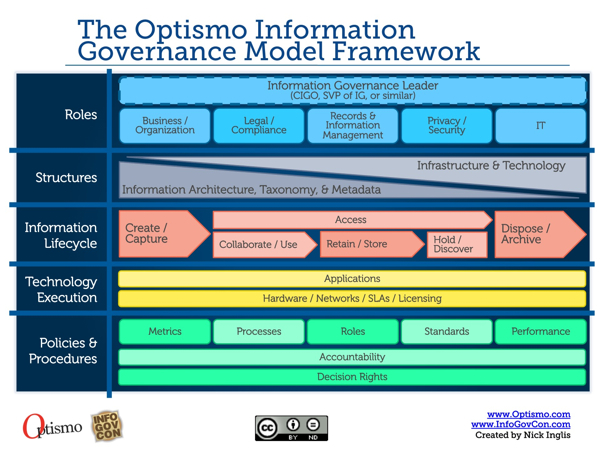
Information governance, as an industry, has been maturing and coming to the forefront at many leading organizations. I’ve had the opportunity to see much of this maturation at various organizations firsthand. We’ve seen the Information Governance Initiative form and release a new definition of information governance. I’ve been a part of the formation of a major conference around the topic. We’ve seen the topic move to the top of discussions at both ARMA, AIIM, AHIMA and other leading industry associations.
The question I’ve been working on solving is to have a viable model for information governance that can be workable for a broad swath of companies. Through the consulting work at my company,Optismo, we have tested a new model several times, learned, made changes to improve the model and are now releasing this model to the public under a Creative Commons License. This is a comprehensive model that brings together all of the various aspects of information governance from the perspective of all stakeholders to information governance.
The question I’ve been working on solving is to have a viable model for information governance that can be workable for a broad swath of companies. Through the consulting work at my company,Optismo, we have tested a new model several times, learned, made changes to improve the model and are now releasing this model to the public under a Creative Commons License. This is a comprehensive model that brings together all of the various aspects of information governance from the perspective of all stakeholders to information governance.
We have aligned our model with much of the work of the Information Governance Initiative in also calling for a position of a chief information governance officer (CIGO) or a position of similar stature in an organization to lead information governance efforts. Under this CIGO or similar position, we list out the various stakeholder groups to information governance and include the business/organization, legal/compliance, records and information management, privacy/security and IT.
Underneath the roles for information governance, we list out the structures in which the roles work with increasing and decreasing significance based on the role. More heavily on the side of the business is the information architecture, taxonomy and metadata. More heavily on the side of IT is the infrastructure and technology.
We then show the processes for an information life cycle, which must be addressed by any information governance plan. The information life cycle begins with creation/capture and moves through to disposal/archiving. While we recognize that information may move from any state to the disposal/archiving stage, it is challenging to show that potential movement linearly and have instead showed that information must be made accessible throughout.
Along with the information life cycle is the underlying technology execution necessary, including applications as well as hardware, networks, service-level agreements and licensing.
We then, for the creators of an information governance plan in an organization, list out the various policies and procedures which must be addressed within the information governance plan, including defining the metrics, processes, roles, standards and performance, all underlined by accountability and decision rights.
I developed this model first to ensure that my consulting clients were able to successfully align their activities in forming an information governance plan to a standard. After several iterations and feedback from many leading experts on information governance, this model was finally completed. It is my hope that this model is able to help organizations achieve information governance success and help guide and inform organizations in the formation of their own information governance plans.
Underneath the roles for information governance, we list out the structures in which the roles work with increasing and decreasing significance based on the role. More heavily on the side of the business is the information architecture, taxonomy and metadata. More heavily on the side of IT is the infrastructure and technology.
We then show the processes for an information life cycle, which must be addressed by any information governance plan. The information life cycle begins with creation/capture and moves through to disposal/archiving. While we recognize that information may move from any state to the disposal/archiving stage, it is challenging to show that potential movement linearly and have instead showed that information must be made accessible throughout.
Along with the information life cycle is the underlying technology execution necessary, including applications as well as hardware, networks, service-level agreements and licensing.
We then, for the creators of an information governance plan in an organization, list out the various policies and procedures which must be addressed within the information governance plan, including defining the metrics, processes, roles, standards and performance, all underlined by accountability and decision rights.
I developed this model first to ensure that my consulting clients were able to successfully align their activities in forming an information governance plan to a standard. After several iterations and feedback from many leading experts on information governance, this model was finally completed. It is my hope that this model is able to help organizations achieve information governance success and help guide and inform organizations in the formation of their own information governance plans.
To download the Optismo Information Governance Model Framework in PPTX format, visit http://optismo.com/ig. Follow Mr. Inglis on Twitter @nickinglis.














